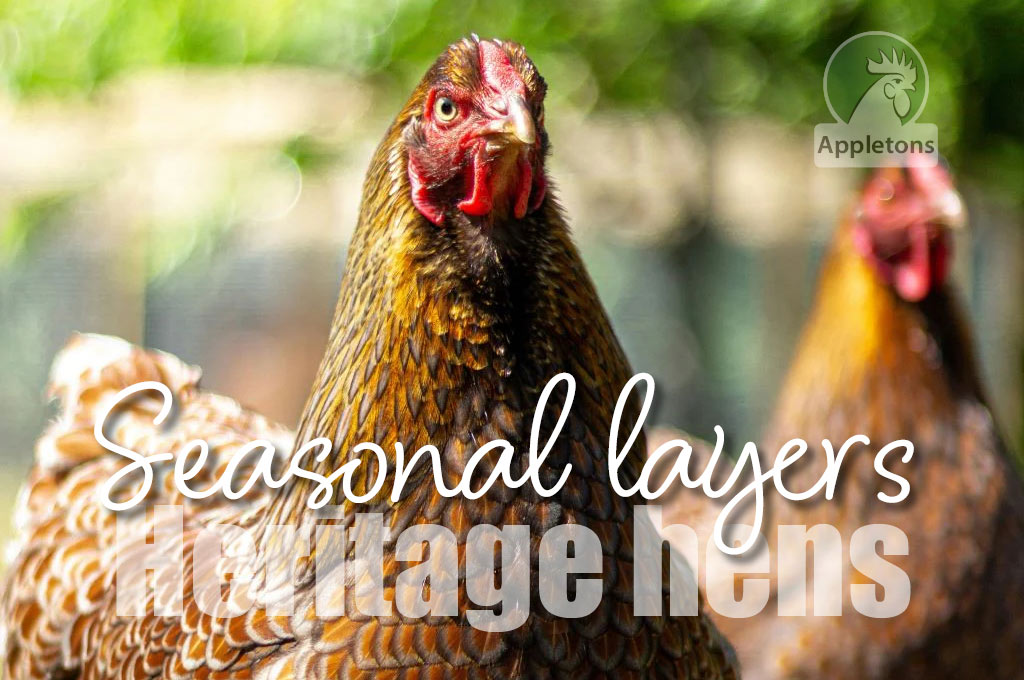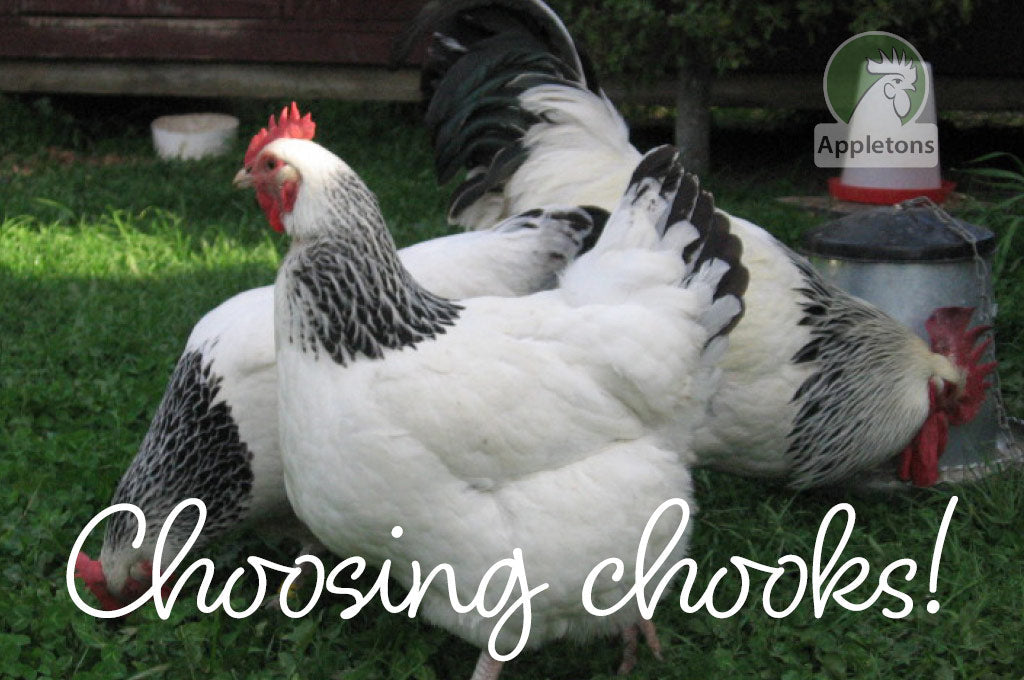Appletons Guide To Raising Your Own Chicks 🐤
Refreshed 4th March 2025, Updated Friday, 22 July 2022, Originally published Tuesday, September 4, 2018
Thinking About Raising Your Own Chicks?
Our news article last month was all about hatching your own chickens. This month we look at the best way to successfully rear these newly hatched chicks to give them the best start in life. Whether you are raising them under a broody (mother hen) or in a brooder box (no mum and under an artificial heat source) here are some helpful tips to make it easy for you.



5 Things to Consider When Raising Chicks

These little black beauties are day old croad langshan chicks.
#1 What Breed?
If you are purchasing day old chicks it is important you select the right breed of chick to suit your requirements.
If you are wanting hens to lay eggs, then choose an egg laying breed. The most efficient and productive are commercial hybrids like the brown shavers or the hyline browns. The beauty about buying from a reputable breeder/hatchery is that you know you are purchasing a female chick that is designed to lay lots of eggs. Commercial hybrids can only be purchased as day old chicks or pullets. They are not available as hatching eggs (fertile eggs) to the public. Day old brown shaver chicks and young brown shaver pullets are readily available from us.
If purchasing a heritage layer there are a few things to consider. Firstly, day old heritage chicks are sold unsexed so potentially half of the chicks you are purchasing could be male. The 50:50 ratio is only an indicator of the average over the season. From hatch to hatch it can vary. There is the possibility you may get 100% boys. The question is will you be able to cope with the boys once they grow up? It is best to have a plan in place on how you wish to deal with these boys once they start to crow. Most councils do not allow for roosters to be kept in urban areas for obvious reasons! Cock-a-doodle-doo! The options are either: to keep (crow collar?), cull and compost (to bury) or to eat or sell. Please note abandoning cockerels in a quiet roadside paddock or into forestry is against the law and cruel on the bird.
Secondly enquire about the productivity of the heritage line you are buying. Some lines have been bred only for looks for showing and the laying ability of the fowl has been reduced. It is also important to understand the difference between the laying ability of heritage and commercial hens.
Commercial hens will lay very well for app 2 years then production will start to decline beyond what is acceptable for most poultry keepers. It is only natural for all hens to lay less eggs as they age. Most backyard chook owners begin to feel that they reach a point where they are feeding out layer feed for little ‘egg’ return. Many chook owners have high expectations form their commercial hybrids and once production starts to fall back they believe it is time to cull or compost.
Heritage chickens are more seasonal layers they lay less eggs overall but take time out to moult and replenish reserves for the new lay season each year. This time out usually happens over autumn, so you will need to be prepared for little or no eggs over a 2 to 3-month period every year.



Swipe for more
#2 Correct Feed
Always use chick starter crumble. Feed it out dry. Make it available all the time.
It is very important that you feed the correct feed to your chicks. The easiest way to get the best feed for your new chicks is to buy a commercial starter crumble. These are formulated to meet all the nutritional needs of a growing chick. We recommend Westons Chicks Choice as it contains vital ruminant proteins which many of the other brands seem to omit these days due to cost.
Never use layer feed for chicks. It contains high levels of calcium in the form of lime flour which will damage the kidneys. You might not see this damage now but as these birds mature into adulthood they can die of kidney failure.
Commercial chick crumble will also contain a coccidiostat, which is a low-level medication to help prevent a parasitic disease called coccidiosis. Coccidiosis can be lethal and wipe out whole clutches of chicks so using a medicated feed is important. If feeding out other feeds alongside your medicated crumble it is worth knowing that due to the very low levels of medication in the feed protection will be lost as the amount is diluted.
A broody hen can eat chick starter along with her chicks until she starts to lay again. Chicks need to stay on the Chick Crumble up to point of lay or 18 weeks.

Premium chick feed with naturally occuring animal proteins will grow good birds.

Premium chick feed with naturally occuring animal proteins will grow good birds.
#3 The Right Heat
Either entrust your chicks to a broody hen and she will provide natural body heat to keep them warm.
Or if using artificial heat, choose between radiant heat (a heat emitter with a reflector) or a contact heat (comfort heat plate).




Swipe for more
#3 The Right Heat
Either entrust your chicks to a broody hen and she will provide natural body heat to keep them warm.
Or if using artificial heat, choose between radiant heat (a heat emitter with a reflector) or a contact heat (comfort heat plate).
#4 Secure Area
Young chicks are very vulnerable to predators like rats, hedgehogs, dogs, feral cats, weasels, ferrets and stoats. These critters can easily reduce your new brood overnight to nothing so placing your new mother hen and her brood in a secure chicken coop with a house and secure run is important.
An Omlet Eglu Chicken Coop is a perfect set up as it has a dry draught free house with a secure run with anti-tunnel skirt. If your run does not have an anti-tunnel skirt, then ensure it has underfloor mesh as stoats and rats can tunnel underneath. Not only does a coop offer security but will also help to keep the mother hen and chicks dry and warm and on the wet, cooler nights this is vital for survival.
Or a dry, clean draught free brooder box if raising them under an artificial source




Swipe for more

#5 Chick Specific Equipment
Best to use the appropriate chick drinkers and feeders for rearing chicks. These are specifically designed to reduce wastage, cleaning and deaths.
If you are improvising sometimes placing a few marbles or pebbles in the water dish can help but chicks don’t think to walk around these open water dishes they walk through them thus making the brooder box and shaving wet. You will be surprised how a chick can drown itself in very little water and once wet chills and dies quickly.
Remember if you have a mother hen with chicks you will need to make sure the drinker is suitable for both an adult bird and chicks. This would need to be a straight sided drinker with a shallow trough for the water. Avoid using a chick drinker if you have a mum hen as her head will not fit under the bowl to drink.
These are specifically designed to reduce wastage, cleaning and deaths.
Broody Hen or Brooder?
There are two options
Let her hatch her own or purchased eggs
OR you slip day old chicks underneath her.
We will have a look at both options.
OPTION #1
Using a Broody Hen to Hatch Her Own Clutch
Once your broody hen has hatched out her brood she will let you know when she is done, and this is usually when she vacates the nest with her young ones in tow in search of a feed and a drink. She will be a super-proud mum clucking and chortling away with her gorgeous new brood in tow!
If your hen (once called missing!) has been sitting out of sight on her eggs in the shrubbery or hidden in the woodpile or just hogging precious space in the layer house now is the time to move her and her young brood to a safe area. Scoop them up along with mum (she will most likely be protective and feisty!) and pop them in a safe and secure coop. We do not recommend shifting her prior to hatching as this sudden move to a new area can put her off her broody intentions. Always worth the wait to move her and make her secure once she has left her nest with her brood. Keep her in this safe coop for at least 4 weeks before you move her to a larger area or run.
Place plenty of shavings in the house (a dry and cosy place to be) and place a drinker with fresh water and feeder full of the correct feed in the run. Remember as you have a mother hen with chicks you will need to make sure the drinker is suitable for both an adult bird and chicks. This would need to be a straight sided drinker with a shallow trough for the water.


OPTION #2
Placing Day Old Chicks Under a Broody Hen
If you have sourced day-old chicks from a breeder, hatchery or from ag day/calf club then most times these can be popped under your broody hen with good success. This will need to be done on day one (hatch day). A mother hen is less inclined to accept older chicks.
Make sure you have a hen that has gone broody for a while and has been sitting on fake or nest eggs for a couple of weeks. It is best to leave the hen sitting where she has chosen to nest and quietly slip your hand under her and remove the fake eggs. Then one at a time slip the day-old chicks below her. All going to plan she should settle on them and think she has hatched them. It is advisable to keep an eye on her and the new chicks for at least 24 hours to ensure she accepts them and none get abandoned and die of cold. Regular check ups even at night are advisable. It is always a good idea to be prepared just in case she abandons them and have a backup ready; a heat source set up in a box.
Many of the broodier breeds like Chinese Silkie, Bantams and Araucana are very good at accepting, mothering and rearing new chicks. The same can be said for many of the heavy breeds like Buff Sussex, Orpington, Dorking, Rhode Island red and we have heard that the odd brown shaver can also make a fine mother hen! Once your new mother has accepted her brood and leaves the nest it is advisable to follow the same plan above of moving her and her brood to a secure coop.
Chicks (without a mother hen) should be kept indoors in a heated brooder until they have their feathers, about 4-8 weeks depending on the time of year.
Rearing Chicks in a Brooder
This is the fun way to do it!
Up close, hands on and make them your friends 🐥🐥🐥


Make Chick Rearing Easy and Invest in one of our Brooder Starter Packages
Shop now for a READY TO GO brooder kit with everything you need to get you started!
Brown shaver chicks feather up quickly. Feed a quality chick crumble with naturally occurring proteins to grow good birds. Make feed availabe all the time.












